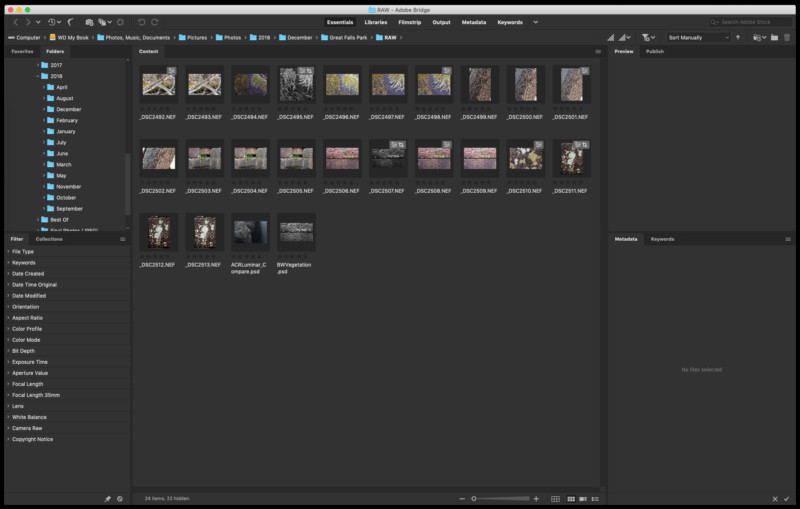Tired of Lightroom? Ditch the Catalog and Try Adobe Bridge
![]()
Over this past year, an increasing trend in photography seems to be finding a viable alternative to Adobe Lightroom. Some have done it to get out from underneath the subscription service while others aren’t pleased with what remains to be inconsistent speed and performance. It seems to be more of the latter than the former, with the Lightroom Catalog largely responsible for the latter.
In the meantime, as photographers try to search for an alternative in a growing market of Digital Asset Managers, a viable alternative already exists within the Adobe ecosystem: Adobe Bridge. All that it requires is to give up the catalog in favor of simple file and folder management.

Obviously, Catalogs do serve a purpose that makes them useful. But I think a fair question to ask is whether the advantages of using Catalogs outweigh the disadvantages. On one hand, Catalogs offer you the ability to easily share photo edits and information with other photographers or clients. Everything is contained within one database file that can be shared.
On the other hand, Catalogs, even with regular maintenance, can become unreliable and slow. Forcing many photographers to try to seek an alternative. I would wager that, if given some serious thought, photographers would find that Catalogs are completely unnecessary. Especially knowing that an alternative to the Catalog already exists through XMP sidecar files.
XMP sidecar files are, essentially, mini-catalogs that keep track of photos edits and other metadata that cannot be stored in the file of the photo. As you can see in the example below, for every photograph there is an XMP file with the same name.

If sharing a photograph with someone, as long as you pair the photograph with its XMP sidecar file, all photo edits and related metadata will come with it. I’ll grant you that sharing photographs and its mirrored XMP sidecar file is not as elegant as the all-in-one Catalog solution, but I can tell you that what you lose you more than make up for in gains elsewhere. One of them is losing Adobe Lightroom in favor of Adobe Bridge.
Adobe Bridge sits in an interesting place in Adobe’s Creative Cloud lineup. It precedes Lightroom by several years and has much the same functionality as Lightroom, however it seems that Adobe Bridge is seen as this extension of Photoshop that acts more like a viewer rather than a legitimate Digital Asset Manager — which is a shame, because Adobe Bridge may very well be the answer to a lot of photographers problems.
It’s true that Adobe Bridge is a ‘Window’s Explorer’, if you will, for your photographic assets, but included is the ability to edit your photos using Adobe Camera Raw. The exact same engine that drives Adobe Lightroom. Same goes for rating photos, filtering photos, and creating collections, among many other similarities.
Adobe Bridge also auto-synchronizes folders by virtue of its management system being a reflection of files and folders; adding or deleting files or folders in Finder or Windows Explorer will be immediately reflected in Adobe Bridge. No more having to synchronize folders in the event the state of the folder and its content changes, like Lightroom. For me, this feature is worth the price of admission alone (that’s almost hyperbole, but not really. I found that it would be difficult to go back).
This only scratches the surface and, yes, there are some features in Lightroom that are not in Adobe Bridge, but the similarities are enough, and the improvement significant enough, to make it a worthy alternative.
In short, Adobe Bridge is the dark horse in the competition of digital asset managers. For those of us who are tied in with the Creative Cloud Suite I would say that Adobe Bridge makes more sense as a digital asset manager versus Lightroom simply because it makes photo management less of a chore, and perhaps more reliable, while maintaining a core level of functionality and familiarity. Photographers would do well to give it a chance and, in the process, may find it’s the alternative they’ve been looking for all along.
If you’re interested in getting started, it’s pretty simple. Begin by enabling XMP sidecar files in either the Lightroom or Adobe Bridge preferences and you’re set!
About the author: Matthew Nordhagen is an architectural and nature photographer. The opinions expressed in this article are solely those of the author. You can find more of Nordhagen’s work on his website. This article was also published here.